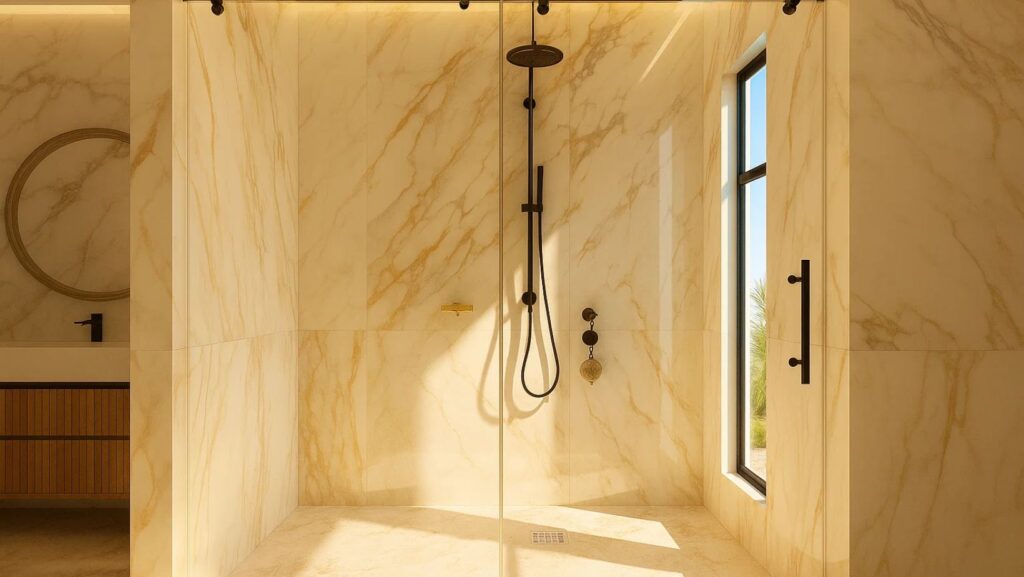
Frameless shower doors have become a defining feature in modern bathroom design. They are sleek, minimal, and give any bathroom a sense of openness that framed enclosures simply can’t match. In this article, we will explore what makes frameless shower doors such a popular choice, the different options available, their advantages, and the sizes you can expect when planning your bathroom renovation.
What Is a Frameless Shower Door?
A frameless shower door is a glass shower enclosure that uses thick tempered glass panels without the need for bulky metal framing around the edges. Instead of relying on full frames, these doors are secured with discreet hardware such as hinges, brackets, and handles.
This design approach delivers two major results:
- A modern, minimalistic look that complements virtually any bathroom style.
- A seamless and open appearance, making small bathrooms feel larger and airy.
Unlike framed shower doors, which often require aluminum or steel outlines for stability, frameless options let the glass itself be the hero of the space.
Why Homeowners in the U.S. Prefer Frameless Shower Doors
1. Aesthetic Appeal
Bathrooms are no longer just functional spaces, they are retreats. Frameless shower doors elevate the overall look, often becoming the focal point of the room. They align with today’s design preferences for clean lines, transparency, and natural light flow.
2. Durability and Strength
Frameless doors typically use 3/8-inch or 1/2-inch-thick tempered safety glass, which is engineered to withstand daily use. Unlike thin glass with metal frames, these panels are heavy, sturdy, and built to last.
3. Customization Options
Many homeowners choose frameless shower doors because they can be tailored to unique layouts, whether you have a compact corner shower or a spacious walk-in design.
4. Resale Value
Upgrading to a frameless shower door can increase the perceived value of your home. Real estate professionals often note that bathrooms with modern glass enclosures attract buyers looking for move-in-ready, updated spaces.
Frameless Shower Door Styles to Consider
Not all frameless shower doors are the same. Depending on your bathroom layout, you can choose from a range of configurations:
Hinged (Swing) Doors
These open outward like a traditional door and are ideal for larger bathrooms where space isn’t restricted.
Sliding Frameless Doors
A great choice for tighter bathrooms, sliding glass doors eliminate the need for door clearance while still offering a sleek look.
Bi-Fold or Pivot Doors
Perfect for small bathrooms, bi-fold or pivot frameless doors fold neatly to maximize entry space.
Walk-In Shower Panels
Instead of a fully enclosed system, some homeowners prefer a fixed frameless glass panel that leaves one side open for a walk-in shower experience.
Glass Options for Frameless Shower Doors
The type of glass you choose also plays a role in aesthetics and privacy. Common options include:
- Clear Glass: The most popular, allowing maximum light and an open feel.
- Frosted or Etched Glass: Provides privacy without sacrificing style.
- Tinted Glass: Available in shades like bronze, gray, or black for a more dramatic effect.
- Textured Glass: Adds depth and personality while diffusing light.
Available Sizes for Frameless Shower Doors
When shopping for a frameless shower door, size is one of the most important considerations. While custom sizes can be made, most options follow these general ranges:
48×72 Inch
This size works well for standard shower stalls in smaller to medium-sized bathrooms. The 72-inch height provides good splash protection without overwhelming compact spaces. It’s ideal when you want a frameless upgrade that fits within a classic shower footprint.
48×76 Inch
Adding four inches in height makes this size excellent for modern bathrooms with higher ceilings or for homeowners who want a sleeker, more expansive look. The taller height also helps minimize water escaping at the top, which is especially useful if you have a powerful showerhead mounted higher on the wall.
60×58 Inch
At 60 inches wide but shorter in height, this size is best suited for bathtub enclosures. It’s a practical fit when replacing old shower curtains with a frameless sliding glass door. The lower 58-inch height makes sense here because it doesn’t need to extend all the way up like a full-height shower enclosure.
60×62 Inch
Similar to the 60″ × 58″ option but slightly taller, this size also works well for tub-shower combinations. The extra height offers better splash protection for families with kids or for taller adults, while still keeping the proportions right for a tub installation.
60×72 Inch
This size is designed for full walk-in showers where the enclosure spans across a wider alcove. The combination of 60-inch width and 72-inch height creates a balanced, modern enclosure that feels open yet contained. It’s one of the most popular choices for master bathrooms aiming for a frameless, spa-like look.
Installation Considerations
While DIY enthusiasts sometimes attempt to install frameless shower doors, most homeowners benefit from hiring professionals. The glass panels are heavy, precise leveling is essential, and proper sealing prevents leaks. Incorrect installation can lead to long-term issues such as water damage or glass misalignment.
That said, understanding the installation process helps you make informed decisions:
- Wall Material: Frameless doors require strong wall backing (often double-stud support) to handle the weight of the glass.
- Hardware Placement: Hinges and brackets must be aligned perfectly.
- Sealing: While frameless doors minimize the need for bulky frames, seals or sweeps are often used at the edges to prevent water from escaping.
Maintenance and Cleaning Tips
Another advantage of frameless shower doors is their low maintenance. Without frames, there are fewer areas where mold and mildew can collect. However, regular upkeep ensures long-lasting clarity:
- Use a squeegee after each shower to prevent water spots.
- Clean glass with mild, non-abrasive cleaners (avoid ammonia-heavy products).
- Apply a glass-protectant coating to repel water and soap scum buildup.
- Check hardware periodically for tightening.
Pros and Cons – A Balanced View
Before deciding, it is wise to weigh both the advantages and limitations.
Pros:
- Modern, elegant design
- Creates a spacious feel
- Durable tempered glass construction
- Customizable to various layouts
- Increases home resale value
Cons:
- Higher upfront cost than framed doors
- Requires professional installation in most cases
- Potential water leakage if not properly sealed
- Heavy glass requires strong wall support
Frameless vs. Framed Shower Doors

Some homeowners wonder if the investment is truly worth it compared to framed doors. Here’s the truth: framed shower doors are less expensive and easier to install, but they often look dated, limit design flexibility, and are harder to keep clean. Frameless doors, on the other hand, deliver timeless style and longevity, making them the better long-term investment for most households.
Trends in U.S. Bathrooms Featuring Frameless Shower Doors
Frameless shower doors are often paired with other modern bathroom upgrades:
- Walk-in showers replacing traditional bathtubs.
- Matte black hardware or brushed gold accents for contrast.
- Large-format tiles or natural stone walls, made more visible through clear glass.
- Open-concept layouts in master bathrooms.
These trends reflect a shift toward spa-inspired bathroom designs that focus on relaxation, openness, and luxury finishes.
Final Thoughts
Frameless shower doors are more than just a bathroom accessory—they’re a design statement. With options in sliding, hinged, or walk-in configurations, along with multiple glass finishes and sizes ranging from 22″ to 80″, they fit nearly any space or style preference.
By choosing a frameless shower door, you’re investing in durability, aesthetics, and a modern bathroom experience that will serve you well for years to come. Whether you’re remodeling a master bath or upgrading a guest bathroom, this sleek solution continues to be one of the most sought-after upgrades for U.S. homeowners.

